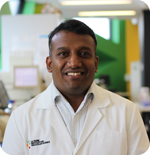Mathivanan Lab
Exosomes
Role of extracellular matrix in cancer
| |||||||||||
| |||||||||||
| |||||||||||
|
1. Samuel, M., Fonseka, P., Sanwlani, R., Gangoda, L., Chee, S.H., Keerthikumar, S., Spurling, A., Chitti, S.V., Zanker, D., Ang, C.S., Atukorala, I., Kang, T., Shahi, S., Marzan, A.L., Nedeva, C., Vennin, C., Lucas, M.C., Cheng, L.,
Herrmann, D., Pathan, M., Chisanga, D., Warren, S.C., Zhao, K., Abraham, N., Anand, S., Boukouris, S., Adda, C.G., Jiang, L., Shekhar, T.M., Baschuk, N., Hawkins, C.J., Johnston, A.J., Orian, J.M., Hoogenraad, N.J., Poon, I.K.,
Hill, A.F., Jois, M., Timpson, P., Parker, B.S. and Mathivanan, S. (2021)
Oral administration of bovine milk-derived extracellular vesicles induces senescence in the primary tumor but accelerates cancer metastasis.
Nature Communications.
3950.
2. Kalra, H., Gangoda, L., Fonseka, P., Chitti, S.V., Liem, M., Keerthikumar, S., Samuel, M., Boukouris, S., Al Saffar, H., Collins, C., Adda, C.G., Ang, C.S. and Mathivanan, S. (2019)
Extracellular vesicles containing oncogenic mutant β-catenin activate Wnt signaling pathway in the recipient cells.
Journal of Extracellular Vesicles.
8:1690217.
3. Zhao, K., Bleackley, M., Chisanga, D., Gangoda, L., Fonseka, P., Liem, M., Kalra, H., Al Saffar, H., Keerthikumar, S., Ang, C.S., Adda, C., Jiang, L., Yap, K., Poon, I., Lock, P., Bulone, P., Anderson, M*. and Mathivanan, S*. (2019)
Extracellular vesicles secreted by Saccharomyces cerevisiae are involved in cell wall remodelling.
Communications Biology.
2:305.
4. Fonseka, P., Liem, M., Ozcitti, C., Adda, C.G., Ang, C.S. and Mathivanan, S. (2019)
Exosomes from N-Myc amplified neuroblastoma cells induce migration and confer chemoresistance to non-N-Myc amplified cells: implications of intra-tumor heterogeneity.
Journal of Extracellular Vesicles. 8:1597614.
5. Pathan, M*., Fonseka, P*., Chitti, S.V., Kang, T., Sanwlani, R., Van Deun, J., Hendrix, A. and Mathivanan, S. (2019)
Vesiclepedia 2019: a compendium of RNA, proteins, lipids and metabolites in extracellular vesicles.
Nucleic Acids Research. D516-D519.
6. Chisanga, D., Keerthikumar, S., Pathan, M., Ariyaratne, D., Kalra, H., Boukouris, S., Mathew, N., Al Saffar, H., Gangoda,
L., Ang, C.S., Sieber, O., Mariadason, J., Dasgupta, R., Chilamkurti, N. and Mathivanan, S. (2016)
Colorectal Cancer Atlas: An integrative resource for genomic and proteomic annotations from colorectal cancer cell lines and tissue.
Nucleic Acids Research. 44(D1), D969-74.
7. Kalra, H., Simpson, R.J., Ji, H., Aikawa, E., Altevogt, P., Askenase, P., Bond, V.C., Borras, F.E., Breakefield, X., Budnik, V., Buzas, E.,
Camussi, G., Clayton, A., Cocucci, E., Falcon-Perez, J.M., Gabrielsson, S., Gho, Y.S., Gupta, D., Harsha, H.C., Hendrix, A., Hill, A.F., Inaal, J.M.,
Jenster, G., Kiang, L.S., Kramer-Albers, E-M., Llorente, A., Lotvall, J., Mincheva-Nilsson, L., Nazarenko, I., Nieuwland, R., Nolte-'t Hoen, E.N.M., Pandey, A.,
Patel, T., Piper, M.G., Pluchino, S., Prasad, T.S.K., Rajendran, L., Raposo, G., Record, M., Reid, G.E., Sanchez-Madrid, F., Schiffelers, R.M., Siljander, P.,
Stoorvogel, W., Taylor, D., Thery, C., Valadi, H., van Balkom, B.W.M., Vazquez, J., Vidal, M., Yanez-Mo, M., Zoeller, M. and
Mathivanan, S. (2012) Vesiclepedia: A compendium for extracellular vesicles with continuous community annotation. PLoS Biology. 12, e1001450.
8. Mathivanan, S., Ahmed, M. et al. (2008). Human Proteinpedia enables sharing of human protein data. Nature Biotechnology. 26, 164-7.
9. Amanchy, R., Periaswamy, B., Mathivanan, S., Reddy, R., Tattikota, S. G. and Pandey, A. (2007). A compendium of curated phosphorylation-based
substrate and binding motifs. Nature Biotechnology. 25, 285-286.
10. Gandhi, T. K. B., Zhong, J., Mathivanan, S., Karthick, L., Chandrika, K. N., Mohan, S. S., Sharma, S., Pinkert, S., Nagaraju, S., Periaswamy, B., Mishra, G., Nandakumar, K., Shen, B., Deshpande, N.,
Nayak, R., Sarker, M., Boeke, J. D., Parmigiani, G., Schultz, J., Bader, J. S. and Pandey, A. (2006). Analysis of the human protein interactome and comparison with yeast, worm and fly interaction
datasets. Nature Genetics. 3, 285-293. | |||||||||||
 BIOGRAPHY - SURESH MATHIVANAN
BIOGRAPHY - SURESH MATHIVANAN




